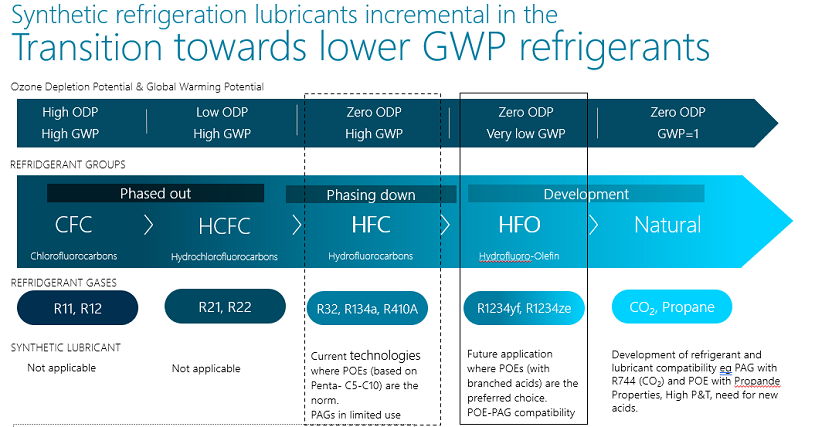Why lubricants matter for sustainable living
When we think of sustainable housing a picture emerges of quality building constructions made of natural and recycled materials surrounded by greenery where our families, friends and entire communities can live and thrive. However the reality is that we are facing great environmental challenges consisting of global warming, limited natural resources and pollution. Therefore we need to carefully evaluate all elements of our modern society and make changes on a broad scale down to the most fundamental components. With this in mind it may not be surprising that also the choice of lubricants can play a significant role in handling these challenges and contribute to sustainable living.
We need lubricants in buildings
Lubricants are often associated with mobility in the form of cars and truck or any other machinery where metal parts move against each other and lubricants are used to reduce the energy lost due to friction. However lubricants serve additional purposes, namely for the air conditioning systems in buildings. With increased standard of living, the trend towards urbanization and the imminent warmer weather conditions, the demand for air conditioning is growing fast. The global demand is expected to triple by 2050 and with it the energy consumption.
Lubricants primary function in AC, HVAC and refrigeration systems is to lubricate the compressor bearings and other moving parts, but there is more than meets the eye when it comes to selection of the right type of lubricant for both lubricant and gas compatibility as well as for the compressor energy efficiency.
Indoor cooling has a negative effect on the environment
The cooling industry accounts for around 10% of global CO2 emissions. According to Project Drawdown, refrigeration management is the number-one way, yes, you read that correctly, to cut greenhouse gas emissions and reverse global warming. The Economist reported back in 2018 that - making Air Conditioning better is pointed out as the single most effective way to reduce greenhouse-gas emissions.
For years very efficient refrigeration gases, such as CFC and HFCF, have been used to absorb hot indoor air and cool it using a compressor. However these refrigerants have been proven to be high contributors to climate change. Especially the Ozone Depleting Potential (ODP) of harmful gases has been a concern which the industry at large has taken seriously. The Montreal Protocol gathered all UN nations to regulate the use of ozone depleting substances and has been pivotal in the successive replacement of high ozone depleting refrigerants to low or non-depleting ones. Since its adoption in 1987, the Montreal Protocol has undergone several revisions including the 2016 Kigali Amendment, which stipulates the gradual reduction of refrigerants with a high global warming potential (GWP) to suppress global warming. This has further accelerated the shift to new refrigerants such as R32, a CFC substitute with a low GWP.
The choice of lubricant matters
The gradual shift to non-ozone depleting and low global warming potential gases such as HFC/HFO in the refrigeration systems requires the use of compatible non-mineral or synthetic lubricant. Chemical and material compatibility of refrigerants are very important parameters given the expectation that HVACR systems will have design lives of 10 to 20+ years.
Polyol ester (POE) based refrigeration lubricants are specially formulated for use with more environmentally friendly HFC/HFO refrigerants and is the most common type of synthetic lubricant being used today. Furthermore, the POE based lubricant can attain properties such as low viscosity that contributes to energy efficiency.
Refrigeration lubricant can save natural resources
While polyol ester compatibility with non-ozone depleting and low global warming potential refrigerant gases takes us closer to sustainable living, more can be done. Lowering emissions of greenhouse gases is vital for limiting future climate change. Currently the highest percentage of manufacturing industries emission is attributed to Scope 3.
Hitting Scope 3 reduction targets can be done by decreasing the use of virgin fossil sources of materials. In the case of polyol ester based lubricants, the virgin fossil raw materials of the acids and polyols that make up the polyol ester can already today be switched to sustainable equivalents. Perstorp Pro-Environment products are based on partly or fully renewable sources that can significantly lower the product carbon footprint.
Cooling without adding to global warming
In summary, by leveraging purpose-designed polyol ester based lubricants, that are compatible with the refrigerant gas, provide energy efficiency gains and are based on non-virgin fossil sources, we can significantly reduce the environmental footprint of cooling systems.
Currently, the shift toward environmentally friendly air conditioners is accelerating, and demand for refrigeration lubricants that are compatible with the refrigerants used in these air conditioners, is also growing. Perstorp produces 90% of the acid and polyol building blocks used to formulate the ester for a refrigeration lubricant. With an eye towards the future, we continue to strengthen our capacity to provide the essential building blocks that are sustainable as well as conduct research and development into refrigeration lubricant raw materials compatible with next-generation refrigerants for extremely low GWP.
Lubricants do matter for sustainable living.
Learn more about World Green Building Week here >>
